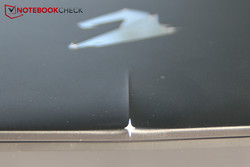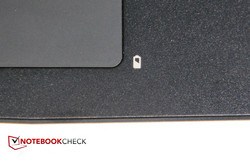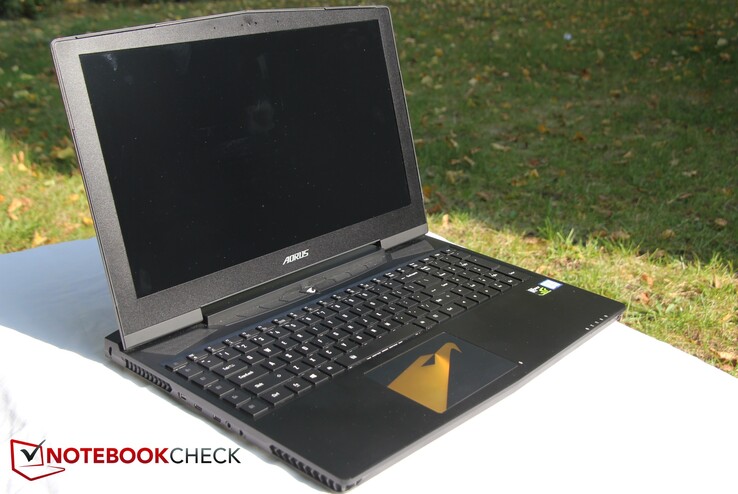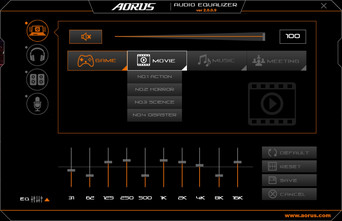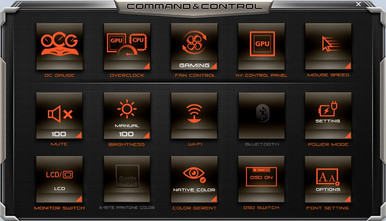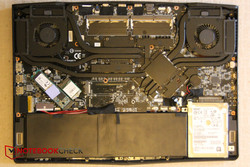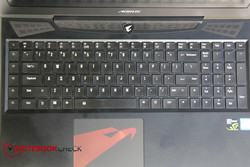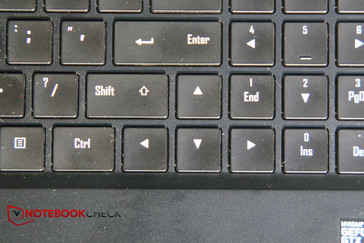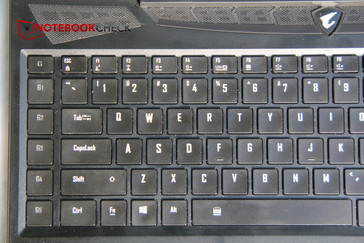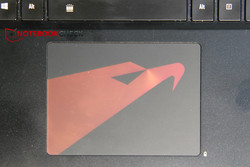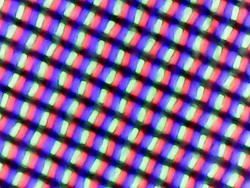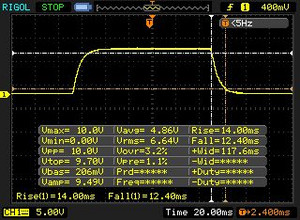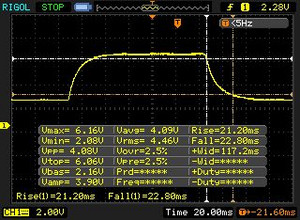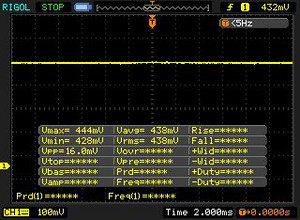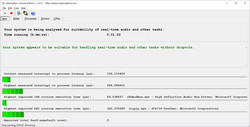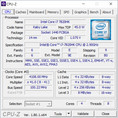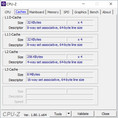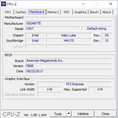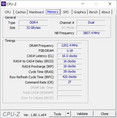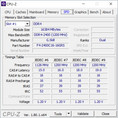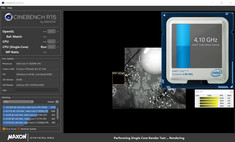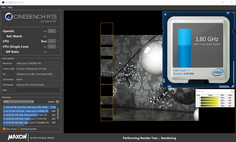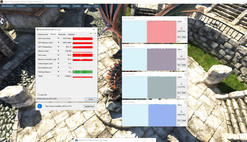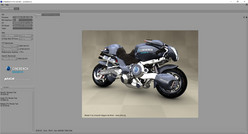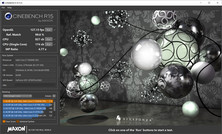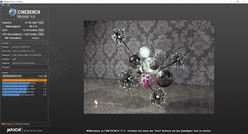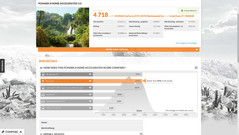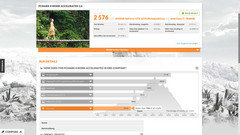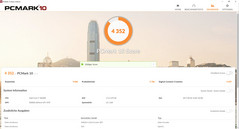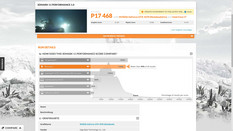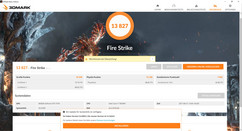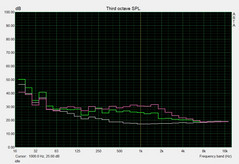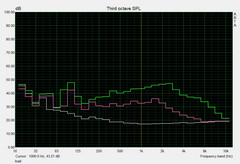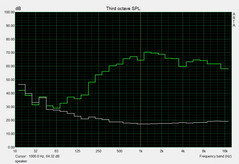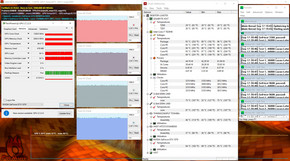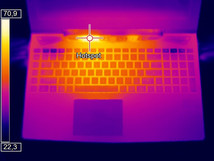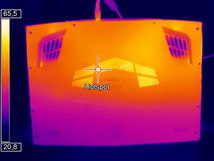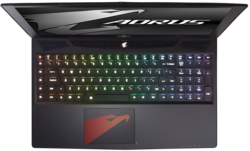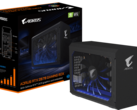Aorus X5 v7 (i7-7820HK, GTX 1070, UHD) Laptop Review

For the original German review, click here.
Aorus is a subsidiary of Gigabyte and is known for fitting potent gaming hardware into slim cases. This is also the case with today's test unit, which is equipped with a Core i7-7820HK, GeForce GTX 1070 and 32 GB of RAM. Its direct predecessor, the Aorus X5 V6, had to submit to our review almost exactly a year ago. Design and performance were good, but the slim design had the usual challenges with its cooling system, and its fans were way too loud.
The Aorus X5 V7 now has a slightly reworked case, for example with new ventilation slots which should make cooling more efficient and minimize fan noise. But the gaming laptop has also been given some technical improvements with a Kaby Lake processor instead of the old Skylake CPU as well as a Thunderbolt 3 port and 4K display. We want to find out whether the new changes deal with the predecessor's faults and how the device fares compared to notebooks such as the Gigabyte P56XT, the Schenker XMG P507, the Eurocom Sky MX5 R3 and the MSI GT62VR 7RE Dominator Pro.
Case
The case of the X5 V7 has been slightly reworked, but its basic characteristics regarding stability and workmanship remain mostly the same. This means that the device sports an elegant, matte-black design with magnesium surfaces and a few color and form highlights. This includes the backlit Aorus logo made from reflective material and positioned at the back of the display and the aesthetic cut in the top center of the display case as well as the red Aorus logo on the touchpad. The many ventilation slots are also quite noticeable as they are placed all around the base unit.
The base unit and keyboard are still very stable but the display cover could be a little more resistant to warping and appears less stable. The hinges are not completely tight and so the display reacts quickly to the slightest jogging of the table or other surfaces it is placed on. But at least the display does not show any discoloration when warped. The general build quality is very good and there are no wide gaps in the material or rattling parts. The battery is still not exchangeable.
Two additional ventilation slots have been added and are positioned on the base unit below the hinges. They support the slots at the side and below and should help the air circulate even better.
Users with a lot of arm hair should beware of the small gaps around the arm and wrist rest which can occasionally pull out a hair or two.
All comparison devices are about the same size with varying thickness. The Aorus X5 V7 does very well in this area, as did its predecessor. The X5 V7 is only 23 mm (~ 0.9 in) thin, which makes it the slimmest device compared to the other four rivals. However, there are even slimmer gaming laptops around, for example the Gigabyte P35X v5 or the MSI GS63VR 6RF Stealth Pro from last year. But overall, our test device is very compact and a little lighter than most competitors at 2.6 kg (~57.3 lbs).
Connectivity
Ports
Aorus has finally given the V7 a Thunderbolt 3 port after we complained that last year's model did not include one. This port has now replaced the predecessor's second HDMI port. The old VGA port has also been replaced by a further USB-A port at the back, which we consider a good decision. Overall, the X5 V7 is now equipped with 4 USB-A ports and 2 USB-C ports (1x incl. Thunderbolt 3). Apart from that, it offers an HDMI 2.0 as well as a Mini DisplayPort 1.3, an SD-card reader and LAN connector. There is a jack each for headphones and microphone.
The ports on the back are a matter of taste. On the one hand, they are a little more difficult to reach, but on the other they free up space at the sides. The spaces between ports are mostly generous; they are a little close to each other on the right side, however, and wide HDMI cables and USB devices might get in the way of each other.
SD-card reader
Testing the card reader with our Toshiba Exceria Pro SDXC 64 GB UHS-II reference card showed that Aorus has also made some less immediately visible changes. While the V6 was fiddling about with transfer rates between 80 and 90 MB/s, the V7 is right at the top with read rates over 200 MB/s. Only the MSI card reader can vaguely keep up with these speeds.
| SD Card Reader | |
| average JPG Copy Test (av. of 3 runs) | |
| Aorus X5 v7 (Toshiba Exceria Pro SDXC 64 GB UHS-II) | |
| MSI GT62VR 7RE-223 (Toshiba Exceria Pro SDXC 64 GB UHS-II) | |
| Eurocom Sky MX5 R3 (Toshiba Exceria Pro SDXC 64 GB UHS-II) | |
| Aorus X5 v6 (Toshiba Exceria Pro SDXC 64 GB UHS-II) | |
| Schenker XMG P507 PRO (Toshiba Exceria Pro SDXC 64 GB UHS-II) | |
| Gigabyte P56XT (Toshiba Exceria Pro SDXC 64 GB UHS-II) | |
| maximum AS SSD Seq Read Test (1GB) | |
| Aorus X5 v7 (Toshiba Exceria Pro SDXC 64 GB UHS-II) | |
| MSI GT62VR 7RE-223 (Toshiba Exceria Pro SDXC 64 GB UHS-II) | |
| Aorus X5 v6 (Toshiba Exceria Pro SDXC 64 GB UHS-II) | |
| Eurocom Sky MX5 R3 (Toshiba Exceria Pro SDXC 64 GB UHS-II) | |
| Gigabyte P56XT (Toshiba Exceria Pro SDXC 64 GB UHS-II) | |
| Schenker XMG P507 PRO (Toshiba Exceria Pro SDXC 64 GB UHS-II) | |
Communication
Our test device did less well at network speeds. Aorus has kept the predecessor's Killer™ Wireless-AC 1535, which is also part of many other gaming notebooks, but it cannot reach its full potential in the Aorus X5 V7. Our test device almost made last place compared to the other devices, although the top-ranked Eurocom Sky MX5 R3 is equipped with the same Wi-Fi hardware.
| Networking | |
| iperf3 transmit AX12 | |
| Eurocom Sky MX5 R3 | |
| MSI GT62VR 7RE-223 | |
| Schenker XMG P507 PRO | |
| Aorus X5 v7 | |
| Gigabyte P56XT | |
| iperf3 receive AX12 | |
| Gigabyte P56XT | |
| Eurocom Sky MX5 R3 | |
| Schenker XMG P507 PRO | |
| MSI GT62VR 7RE-223 | |
| Aorus X5 v7 | |
Software
Again, Aorus has given the V7 its own software package. Particularly the Command & Control tool is very useful as it lets you regulate a lot of laptop parameters easily and quickly. For example, you can change power settings, overclock the GPU and CPU or adapt fan regulation.
However, the tool window is a little too small on the integrated 4K display and its size cannot be modified. This means that you need to move closer to the screen in order to read the small lettering on the even smaller buttons. Still, this is a very practical tool for the X5 V7.
Additionally, you will find an Aorus Audio Equalizer. This enables you to change between various audio profiles such as Gaming, Movie, Music etc. and even choose the kind of movie (e.g. Horror, Sci-Fi), change volume, adjust microphone sensitivity and manually create and save your own equalizer profiles.
Accessories
Apart from the laptop and power supply, you will also receive a quick-start guide, a very small USB stick with drivers and warranty information.
Maintenance
Maintenance has not changed since the last version, but that was not necessary anyway. After all, the bottom of the V6 base unit was easy to remove and gave access to the internal hardware. The same goes for the new V7. Twelve screws need to be unscrewed, and they are all easily visible. The only avoidable challenge is for users who do not have the suitable Torx screwdriver (T6), as Asus continues to use these screws for its devices.
Removing the bottom gives you access to the battery, the BIOS, the M.2 Wi-Fi module and the three hard-drive bays, two of which are in M.2 format. The processor and graphics chip are still firmly soldered on and unfortunately access to the RAM is complicated, as it is not immediately visible and probably placed below the motherboard. This is OK in our case as the RAM is a large 32 GB, but the V7 is also available with 8 and 16 GB. Upgrading the primary RAM is unnecessarily complicated.
Warranty
The manufacturer's warranty for the laptop is the standard two years, but this is not valid for all parts of the device. The battery, for example, only has a one-year warranty.
We would definitely recommend checking the display for bright pixels after purchase, as the manufacturer will only change the display due to faulty, bright pixels for free within the first 30 days after purchase, and only if you can show them your receipt.
Please see our Guarantees, Return Policies & Warranties FAQ for country-specific information.
Input Devices
Keyboard
Despite the short travel, typing is comfortable and easy on this keyboard. The typing noise is not too bad, although it could be a little quieter. The only thing we are not quite sure about is the layout. As there is not a lot of available space, the arrow keys were not given their own area but intrude both into the number block and into the left side of the keyboard. The enter key is also rather small and narrow.
We also had to get used to the macro keys, although we realize that they are useful. They are positioned to the left of the normal keyboard and at first we occasionally hit them instead of the Ctrl or shift-key. But it does not take long to get used to all this, as well as the unusually angular typeface used to mark the keys.
Similarly to its predecessor, each key of the V7 is individually backlit. This feature has been implemented better this time and backlighting is more consistent, even around large keys. Aorus also seems to have dealt with the predecessor's flickering of the backlight when macro profiles are changed. Another point of criticism we had last year was that the upper G-key did not always respond properly. This also seems to have been fixed in the V7.
Touchpad
The touchpad seems unchanged since the V6. It works well; the smooth matte surface allows for easy gliding and the size of the pad is quite generous. The clicking sound of the keys is satisfyingly quiet.
The left mouse key could sometimes be more precise. Particularly when you press it towars the middle of both keys, the touchpad does not always register it as a left click. Multi-touch gestures, however, work fine.
Display
The display in our test unit is a 4K panel from AU Optronics. The matte, 3840x2160 IPS panel can also be exchanged for a WXHD (2880x1620) version. Both displays support Nvidia G-Sync. Unfortunately, we do not know whether the predecessor's WXHD display problems regarding screen-bleeding, bad brightness distribution and PWM at all brightness levels have been solved, but the 4K display is not affected by these problems. We only noticed a little screen-bleeding at the bottom edge after a closer look. This is so low that it is hardly visible in the photo.
There is no PWM, the brightness distribution of 92% is one of the best in our comparison field (only the Eurocom has similar results) and most other results of our display are also very convincing. Only brightness (297 cd/m2) could be a little stronger. The Schenker (365 cd/m2) and the Eurocom (409 cd/m2) both have better brightness levels.
| |||||||||||||||||||||||||
Brightness Distribution: 92 %
Center on Battery: 307 cd/m²
Contrast: 1023:1 (Black: 0.3 cd/m²)
ΔE ColorChecker Calman: 4.72 | ∀{0.5-29.43 Ø4.78}
ΔE Greyscale Calman: 4.79 | ∀{0.09-98 Ø5}
92% sRGB (Argyll 1.6.3 3D)
60% AdobeRGB 1998 (Argyll 1.6.3 3D)
66.3% AdobeRGB 1998 (Argyll 3D)
91.9% sRGB (Argyll 3D)
65.3% Display P3 (Argyll 3D)
Gamma: 2.42
CCT: 7690 K
| Aorus X5 v7 AU Optronics B156ZAN02.3 (AUO23EB), 3840x2160, 15.6" | Aorus X5 v6 2880x1620, 15.6" | Gigabyte P56XT LG Philips LP156WF6 (LGD046F), 1920x1080, 15.6" | Schenker XMG P507 PRO AUO B156HTN05.2 (AUO52ED), 1920x1080, 15.6" | Eurocom Sky MX5 R3 ID: AUO52ED, Name: AU Optronics B156HTN05.2, 1920x1080, 15.6" | MSI GT62VR 7RE-223 LG Philips LP156WF6 (LGD046F), 1920x1080, 15.6" | |
|---|---|---|---|---|---|---|
| Display | -5% | -5% | -1% | -2% | -7% | |
| Display P3 Coverage (%) | 65.3 | 62.5 -4% | 64.8 -1% | 66.4 2% | 65.9 1% | 63.9 -2% |
| sRGB Coverage (%) | 91.9 | 86.2 -6% | 84.6 -8% | 88.9 -3% | 87.8 -4% | 83.1 -10% |
| AdobeRGB 1998 Coverage (%) | 66.3 | 62.5 -6% | 61.8 -7% | 65.1 -2% | 64.2 -3% | 60.8 -8% |
| Response Times | 1% | 11% | 50% | 60% | 11% | |
| Response Time Grey 50% / Grey 80% * (ms) | 44 ? | 34 ? 23% | 37.2 ? 15% | 24 ? 45% | 20.8 ? 53% | 37 ? 16% |
| Response Time Black / White * (ms) | 26.4 ? | 32 ? -21% | 24.8 ? 6% | 12 ? 55% | 8.8 ? 67% | 25 ? 5% |
| PWM Frequency (Hz) | 198.4 | 20000 ? | ||||
| Screen | -3% | -14% | -38% | -48% | -3% | |
| Brightness middle (cd/m²) | 307 | 280.4 -9% | 301 -2% | 357 16% | 416.2 36% | 310 1% |
| Brightness (cd/m²) | 297 | 271 -9% | 280 -6% | 365 23% | 409 38% | 311 5% |
| Brightness Distribution (%) | 92 | 83 -10% | 87 -5% | 85 -8% | 94 2% | 85 -8% |
| Black Level * (cd/m²) | 0.3 | 0.249 17% | 0.32 -7% | 0.5 -67% | 0.86 -187% | 0.3 -0% |
| Contrast (:1) | 1023 | 1126 10% | 941 -8% | 714 -30% | 484 -53% | 1033 1% |
| Colorchecker dE 2000 * | 4.72 | 4.94 -5% | 6.21 -32% | 9.93 -110% | 8.4 -78% | 4.82 -2% |
| Colorchecker dE 2000 max. * | 8.07 | 8.13 -1% | 10.78 -34% | 14.87 -84% | 15.4 -91% | 10.14 -26% |
| Greyscale dE 2000 * | 4.79 | 5.13 -7% | 6.08 -27% | 10.32 -115% | 11.2 -134% | 3.94 18% |
| Gamma | 2.42 91% | 2.26 97% | 2.31 95% | 2.11 104% | 2.23 99% | 2.45 90% |
| CCT | 7690 85% | 7433 87% | 7375 88% | 10096 64% | 10036 65% | 6877 95% |
| Color Space (Percent of AdobeRGB 1998) (%) | 60 | 55.9 -7% | 55 -8% | 58 -3% | 57.2 -5% | 54 -10% |
| Color Space (Percent of sRGB) (%) | 92 | 85.9 -7% | 84 -9% | 89 -3% | 87.3 -5% | 83 -10% |
| Total Average (Program / Settings) | -2% /
-3% | -3% /
-9% | 4% /
-19% | 3% /
-24% | 0% /
-2% |
* ... smaller is better
Color-space coverage is not particularly important for gaming, but anyway, the V7's results (90% sRGB, 60% AdobeRGB) are quite decent. The same can be said for the contrast ratio of 1023:1 as well as the black value and color deviation. Overall, the 4K display has very good results, which our personal impression confirms. Colors appear rich without being unnatural. Text is very sharp due to the high resolution and black also appears deep. Both available displays of the X5 V7 were professionally calibrated and certified by X-Rite™ Pantone®, which is supposed to ensure even more natural-looking colors.
The only thing that could bother passionate gamers is the relatively high latencies, which can cause some streaking and motion blur in fast shooters. Overall, however, the display convinced us in almost all areas.
The screen is still readable outdoors, even in sunlight - as long as it is not direct sunlight. Nonetheless, brightness could be higher (over 300 cd/m2). The matte screen does swallow most reflections which makes the V7 suitable for outdoor use - apart from its battery life (see below).
Display Response Times
| ↔ Response Time Black to White | ||
|---|---|---|
| 26.4 ms ... rise ↗ and fall ↘ combined | ↗ 14 ms rise | |
| ↘ 12.4 ms fall | ||
| The screen shows relatively slow response rates in our tests and may be too slow for gamers. In comparison, all tested devices range from 0.1 (minimum) to 240 (maximum) ms. » 65 % of all devices are better. This means that the measured response time is worse than the average of all tested devices (20.2 ms). | ||
| ↔ Response Time 50% Grey to 80% Grey | ||
| 44 ms ... rise ↗ and fall ↘ combined | ↗ 21.2 ms rise | |
| ↘ 22.8 ms fall | ||
| The screen shows slow response rates in our tests and will be unsatisfactory for gamers. In comparison, all tested devices range from 0.165 (minimum) to 636 (maximum) ms. » 73 % of all devices are better. This means that the measured response time is worse than the average of all tested devices (31.6 ms). | ||
Screen Flickering / PWM (Pulse-Width Modulation)
| Screen flickering / PWM not detected | |||
In comparison: 53 % of all tested devices do not use PWM to dim the display. If PWM was detected, an average of 8108 (minimum: 5 - maximum: 343500) Hz was measured. | |||
Performance
Aorus has given the processor an update. Last year, the V6 was equipped with a Skylake processor from Intel, the Core i7-6820HK. Now, the V7 is equipped with a more up-to-date Core i7-7820HK. This is still supported by the very potent Nvidia GeForce GTX 1070 with 8 GB of GDDR5 memory. Both the CPU and the GPU can easily be overclocked. You can choose between 8, 16 and 32 GB of working memory. As mentioned above, our test unit is equipped with 32 GB of RAM.
This means that the device is primarily directed at passionate gamers who wish to remain mobile with a laptop that has a compact case. But the potent hardware and good 4K panel also lend themselves to video and image-processing, at least for semi-professional use (see color-space coverage in the Display section).
Processor
The processor Aorus has chosen for the V7 is the very fast Intel Core i7-7820HK. At the time of launch, the quad-core CPU that supports Hyper-Threading is the second-fastest processor of the series. Therefore, it should be well-equipped for all tasks and uses. The processor clocks between 2.9 and 3.9 GHz and can additionally be overclocked in the Aorus. Unfortunately, the integrated graphics unit Intel HD Graphics 630 cannot be used at all as the device does not support Optimus (Nvidia still has not enabled simultaneous running of G-Sync and Optimus).
Due to the overclocking option for CPU and GPU via the Command & Control software, the device's components are even more powerful than the standard versions. As it is so easy to set up and the clock rates seemed stable during a Cinebench test run, we decided to run our tests with a medium overclock. Usually at this setting, the CPU clocks at up to 4.1 instead of 3.9 GHz.
The processor cores clock steadily between 3.8 and 3.9 GHz during the 30-minute Cinebench R15 loop (multi-core). They do not reach the maximum clock rate of 4.1 GHz, but the almost 3.9 GHz is constant and there is no throttling. The clock rates during the Cinebench test did not drop noticeably on battery.
As the competing notebooks probably do not clock at the maximum turbo rate, the overclocking is noticeable and the Aorus X5 V7 is at the top of our comparison table in all Cinebench tests. The results are also higher than the average results of the Intel Core i7-7820HK from the benchmark section. Last year's V6 was already at the top here and this model has done even better. Overall, the performance of the Aorus gives a very good impression.
| Cinebench R11.5 | |
| CPU Single 64Bit | |
| Aorus X5 v7 | |
| Aorus X5 v6 | |
| Eurocom Sky MX5 R3 | |
| Gigabyte P56XT | |
| Schenker XMG P507 PRO | |
| MSI GT62VR 7RE-223 | |
| CPU Multi 64Bit | |
| Aorus X5 v7 | |
| Aorus X5 v6 | |
| Eurocom Sky MX5 R3 | |
| Gigabyte P56XT | |
| Schenker XMG P507 PRO | |
| MSI GT62VR 7RE-223 | |
| Cinebench R10 | |
| Rendering Single CPUs 64Bit | |
| Aorus X5 v7 | |
| Rendering Multiple CPUs 64Bit | |
| Aorus X5 v7 | |
System Performance
System performance paints a different picture, however: Our tests with PCMark 8 only deliver average Home Score results. Performance is even worse during the Work Score test and the device is 50% below the second-to-last device in our comparison table, which is the predecessor, V6. If you run the benchmark in the conventional mode (not accelerated), the V7 can reach almost 1000 points more in the Work Score, which indicates that there might be some problems in the OpenGL or with other drivers. On the other hand, it could be PCMark 8 itself. As the notebook did not appear to have any other problems or limitations, we are considering the Work Score as an outlier.
| PCMark 8 | |
| Home Score Accelerated v2 | |
| Eurocom Sky MX5 R3 | |
| MSI GT62VR 7RE-223 | |
| Aorus X5 v6 | |
| Aorus X5 v7 | |
| Schenker XMG P507 PRO | |
| Gigabyte P56XT | |
| Work Score Accelerated v2 | |
| MSI GT62VR 7RE-223 | |
| Gigabyte P56XT | |
| Eurocom Sky MX5 R3 | |
| Schenker XMG P507 PRO | |
| Aorus X5 v6 | |
| PCMark 10 - Score | |
| Gigabyte P56XT | |
| PCMark 8 Home Score Accelerated v2 | 4718 points | |
Help | ||
Storage Devices
The Aorus X5 V7 has two storage drive bays: the 256-GB SSD from Toshiba is home to Windows 10 64-bit and is placed 34th in our SSD/HDD benchmark list. It has good transfer rates and can keep up quite well with its competition. But most of our comparison devices are also equipped with similarly good SSDs, which means that the Aorus cannot overtake them in this category. Only the main storage device of the MSI has a significantly lower result, even though it is also equipped with an SSD.
Aorus' secondary storage device is a 1-TB HGST Travelstar HDD. It runs at 7200 rpm and serves as main storage and gaming drive, as the 256 GB of the SSD is soon filled up with the operating system and other programs. The HGST Travelstar is also listed on our benchmark list - in place 549. Despite appearances, it is one of the highest-ranking HDDs after the many SSDs and has rather good characteristics for an HDD.
| Aorus X5 v7 Toshiba NVMe THNSN5256GPU7 | Aorus X5 v6 Samsung SM951 MZVPV256 m.2 | Schenker XMG P507 PRO Samsung SSD 960 Evo 500GB m.2 NVMe | Eurocom Sky MX5 R3 Samsung SSD 960 Evo 500GB m.2 NVMe | MSI GT62VR 7RE-223 Samsung SSD PM871a MZNLN256HMHQ | |
|---|---|---|---|---|---|
| CrystalDiskMark 3.0 | 3% | 14% | 2% | -47% | |
| Write 4k QD32 (MB/s) | 556 | 358.7 -35% | 546 -2% | 511 -8% | 257.9 -54% |
| Read 4k QD32 (MB/s) | 697 | 688 -1% | 668 -4% | 524 -25% | 388.4 -44% |
| Write 4k (MB/s) | 137.8 | 158.8 15% | 177.5 29% | 152.7 11% | 122.8 -11% |
| Read 4k (MB/s) | 44 | 53 20% | 59.1 34% | 58.8 34% | 38.55 -12% |
| Write 512 (MB/s) | 1101 | 1221 11% | 1216 10% | 1132 3% | 286.9 -74% |
| Read 512 (MB/s) | 1086 | 990 -9% | 873 -20% | 840 -23% | 462 -57% |
| Write Seq (MB/s) | 1076 | 1275 18% | 1635 52% | 1521 41% | 422.8 -61% |
| Read Seq (MB/s) | 1479 | 1565 6% | 1718 16% | 1219 -18% | 521 -65% |
Graphics
The V7 is equipped with the same graphics card as its predecessor was: the fast Nvidia GeForce GTX 1070. This is currently the second-fastest mobile graphics card (without SLI) and should satisfy even the highest gaming requirements. Similarly to the CPU, the GPU can also be overclocked easily via Aorus' Command & Control tool. We ran our tests on the middle of four available levels (level 1 = standard).
The Aorus managed good results in 3DMark 2013 and went right to the top of the list of comparison devices in Cloud Gate. The Fire Strike test positioned it in the midfield. Our test device managed similarly average results in 3DMark 11.
GPU performance is throttled significantly on battery. In The Witcher 3, the frame rate in 4K and high settings dropped from 39 fps to only 27 fps, which equates to a performance loss of 30%. Subjectively, we felt that it was even worse and the game could not be played without juddering in these settings.
As the notebook is supported by Nvidia G-Sync it cannot have Nvidia Optimus. This means that the GTX 1070 is constantly active, which brings high performance but also high-power consumption.
| 3DMark | |
| 1920x1080 Fire Strike Score | |
| Aorus X5 v6 | |
| Eurocom Sky MX5 R3 | |
| Aorus X5 v7 | |
| MSI GT62VR 7RE-223 | |
| Gigabyte P56XT | |
| Schenker XMG P507 PRO | |
| 1280x720 Cloud Gate Standard Score | |
| Aorus X5 v7 | |
| Aorus X5 v6 | |
| Eurocom Sky MX5 R3 | |
| MSI GT62VR 7RE-223 | |
| Gigabyte P56XT | |
| Schenker XMG P507 PRO | |
| 3DMark 11 - 1280x720 Performance | |
| Aorus X5 v6 | |
| Eurocom Sky MX5 R3 | |
| Aorus X5 v7 | |
| Schenker XMG P507 PRO | |
| Gigabyte P56XT | |
| MSI GT62VR 7RE-223 | |
| 3DMark 11 Performance | 17468 points | |
| 3DMark Cloud Gate Standard Score | 30201 points | |
| 3DMark Fire Strike Score | 13827 points | |
Help | ||
Gaming Performance
The Aorus X5 V7 has sufficient performance to display all current games in Full HD and Ultra settings. But the notebook has a 4K screen, which means that maximum sharpness can only be reached in native resolution. Most games can also be played well in 4K, but not always with Ultra settings. For example, our test of Rise of the Tomb Raider in 4K and high graphics settings resulted in an average of 36 fps. This is sufficient, but it can lead to juddering in some very demanding scenes of the game. The Witcher 3 runs at an average of 39 fps in these settings. We would not recommend switching to Ultra settings, as this further decreases the fps rate. Doom runs smoothly in 4K and high settings at over 50 fps.
Playing The Witcher 3 for a longer period of time showed that the GTX 1070 turbo decreases slightly after a longer gaming session. The frame rate dropped from an initial 61 fps to 55 fps. This is a loss of almost 10%. For 4K measurements, this would mean a drop to 35 fps and below, which only offers a very narrow margin for more-demanding scenes.
It is difficult to compare our device's gaming performance with those of its competitors as we have little data available of how the three tested games ran on the comparison devices. It is clear, however, that the V7 does not always rank at the top despite overclocking. It does manage best performance with Doom both in Full HD and Ultra settings, but its performance in The Witcher 3 and Rise of the Tomb Raider is merely average - the Eurocom is quicker in some of these games. Overall, the measurements are normal for a GTX 1070, although they should be better due to the slight overclocking we set it to. But although the Aorus could not beat its competition despite overclocking, its general gaming performance is still very good.
| The Witcher 3 | |
| 1920x1080 Ultra Graphics & Postprocessing (HBAO+) | |
| Eurocom Sky MX5 R3 | |
| Aorus X5 v7 | |
| Gigabyte P56XT | |
| 3840x2160 High Graphics & Postprocessing (Nvidia HairWorks Off) | |
| Aorus X5 v7 | |
| Rise of the Tomb Raider | |
| 1920x1080 Very High Preset AA:FX AF:16x | |
| Eurocom Sky MX5 R3 | |
| Aorus X5 v6 | |
| Aorus X5 v7 | |
| 3840x2160 High Preset AA:FX AF:4x | |
| Aorus X5 v7 | |
| Doom | |
| 1920x1080 Ultra Preset AA:SM | |
| Aorus X5 v7 | |
| Aorus X5 v6 | |
| Eurocom Sky MX5 R3 | |
| 3840x2160 High Preset AA:FX | |
| Aorus X5 v7 | |
| low | med. | high | ultra | 4K | |
|---|---|---|---|---|---|
| The Witcher 3 (2015) | 264.4 | 192.1 | 86.8 | 61.1 | 39.19 |
| Rise of the Tomb Raider (2016) | 250 | 183.6 | 117.7 | 96.9 | 36.52 |
| Doom (2016) | 169.4 | 169.7 | 144.2 | 139.4 | 53.3 |
Emissions
System Noise
The above-mentioned Command & Control tool lets you adjust the cooling system, at least by switching between three profiles: Gaming, Normal and Quiet. When you activate the latter, the cooling fans stop completely while idling. At the request of Gigabyte, we ran the tests in the Gaming mode.
The criticized loud cooling fans have only partly been improved in the V7. But you can tell that some changes were made to deal with this issue. The noise level has noticeably improved in 3D applications. The volume under average load has dropped from the 53 dB(A) of the V6 to 43 dB(A) - an enormous improvement. The differences are not so big under higher loads, but the V7 still remains quieter under load than its predecessor. This can definitely be considered an improvement. The V7 still only managed average results compared to the other devices.
The device seems to have become louder while idling, however. The difference is small, but it is still worth noting. The current Aorus was the loudest device among our comparison devices while idling, although there is not much difference. But of course, this is also connected to the Gaming mode. If you change the profile to Quiet, the cooling fans can even fall silent at times - depending on the load.
But none of the devices really manage great results here. The Eurocom is considerably quieter while idling but then louder under load, where most gaming devices have similar values anyway. We did not notice any coil whine or other particular background noises during the test.
Noise level
| Idle |
| 35 / 36 / 40 dB(A) |
| HDD |
| 33 dB(A) |
| Load |
| 43 / 55 dB(A) |
 | ||
30 dB silent 40 dB(A) audible 50 dB(A) loud |
||
min: | ||
| Aorus X5 v7 i7-7820HK, GeForce GTX 1070 Mobile | Aorus X5 v6 6820HK, GeForce GTX 1070 Mobile | Gigabyte P56XT i7-7700HQ, GeForce GTX 1070 Mobile | Schenker XMG P507 PRO i7-7700HQ, GeForce GTX 1070 Mobile | Eurocom Sky MX5 R3 i7-7820HK, GeForce GTX 1070 Mobile | MSI GT62VR 7RE-223 i7-7700HQ, GeForce GTX 1070 Mobile | |
|---|---|---|---|---|---|---|
| Noise | -1% | 4% | -1% | 9% | 7% | |
| off / environment * (dB) | 30 | 29.3 2% | 30 -0% | 31 -3% | 28 7% | 30 -0% |
| Idle Minimum * (dB) | 35 | 33.4 5% | 34 3% | 33 6% | 28.5 19% | 34 3% |
| Idle Average * (dB) | 36 | 35.2 2% | 35 3% | 34 6% | 29.2 19% | 35 3% |
| Idle Maximum * (dB) | 40 | 35.2 12% | 39 2% | 44 -10% | 35.5 11% | 36 10% |
| Load Average * (dB) | 43 | 53.3 -24% | 39 9% | 46 -7% | 47 -9% | 40 7% |
| Witcher 3 ultra * (dB) | 49 | 48 2% | ||||
| Load Maximum * (dB) | 55 | 57.6 -5% | 49 11% | 52 5% | 51 7% | 46 16% |
* ... smaller is better
Temperature
It is no secret that gaming laptops produce a lot of heat due to their potent hardware and can reach high temperatures even despite good cooling systems. However, the predecessor of the V7 already started heating up unnaturally while idling. Luckily, this has been improved in the V7 which has good temperatures between 29 and 30 °C (~84.2 - 86 °F).
This changes a little under load: the V7 heated up more than its predecessor during the stress test and while temperatures only increased a little on the bottom of the base unit (average), they went up to 64 °C (~147.2 °F) on the top. This makes the new Aorus the hottest device of the comparison field (together with the Gigabyte). The high temperatures may be connected to the reworked cooling system which is trying to be quieter but now cools less under load.
On top of that, the hottest area is the top left side, where gamers would usually lay their fingers onto the WASD keys. Very demanding games and sequences can make this area heat up to uncomfortable temperatures. Subjectively, we felt that the W key heated up most. Gaming notebooks usually are not suitable for having on your lap while gaming anyway, unless you are in very cold surroundings. Despite our measurements claiming the opposite, we felt that the bottom of the Aorus heated up more than the top.
We let FurMark and Prime95 run simultaneously for an hour in our ultimate stress test. During this test, the cores of the Core i7-7820HK heated up to a maximum of 96 °C (~204.8 °F) before they started to throttle. After an hour, the clock rate had stabilized itself around 3.3 GHz with a core temperature of 90-95 °C (~194 - 203 °F). The GPU ran at 1300 MHz after an hour and had a temperature of 84 °C (~183.2 °F).
Of course, this would only occur in an extreme stress situation. Overall, the Aorus has average temperatures. The MSI GT62VR had the best results here and can be considered the coolest notebook of our comparison devices.
(-) The maximum temperature on the upper side is 64 °C / 147 F, compared to the average of 40.4 °C / 105 F, ranging from 21.2 to 68.8 °C for the class Gaming.
(-) The bottom heats up to a maximum of 56 °C / 133 F, compared to the average of 43.3 °C / 110 F
(+) In idle usage, the average temperature for the upper side is 27.2 °C / 81 F, compared to the device average of 33.9 °C / 93 F.
(-) Playing The Witcher 3, the average temperature for the upper side is 43.7 °C / 111 F, compared to the device average of 33.9 °C / 93 F.
(±) The palmrests and touchpad can get very hot to the touch with a maximum of 38 °C / 100.4 F.
(-) The average temperature of the palmrest area of similar devices was 28.9 °C / 84 F (-9.1 °C / -16.4 F).
| Aorus X5 v7 i7-7820HK, GeForce GTX 1070 Mobile | Aorus X5 v6 6820HK, GeForce GTX 1070 Mobile | Gigabyte P56XT i7-7700HQ, GeForce GTX 1070 Mobile | Schenker XMG P507 PRO i7-7700HQ, GeForce GTX 1070 Mobile | Eurocom Sky MX5 R3 i7-7820HK, GeForce GTX 1070 Mobile | MSI GT62VR 7RE-223 i7-7700HQ, GeForce GTX 1070 Mobile | |
|---|---|---|---|---|---|---|
| Heat | -9% | -13% | -3% | 2% | 18% | |
| Maximum Upper Side * (°C) | 64 | 57 11% | 65 -2% | 49.2 23% | 50 22% | 40.6 37% |
| Maximum Bottom * (°C) | 56 | 54 4% | 71 -27% | 62 -11% | 52.2 7% | 48.4 14% |
| Idle Upper Side * (°C) | 29 | 36.2 -25% | 35 -21% | 32.4 -12% | 33.2 -14% | 26.8 8% |
| Idle Bottom * (°C) | 30 | 38 -27% | 30 -0% | 33 -10% | 32.4 -8% | 26.4 12% |
* ... smaller is better
Speakers
The Aorus is equipped with two 1.5-watt speakers and two 2-watt woofers. You would expect good sound and decent volume from this combination and subjectively, the V7 did offer more bass. But only a little more and the low volume cannot produce loud bangs or play music loud enough even in quiet surroundings. The sound spectrum is also rather meager.
We would recommend connecting headphones or external speakers for a more immersive gaming experience. The device offers two audio jacks, one for headphones and one for a microphone.
Aorus X5 v7 audio analysis
(±) | speaker loudness is average but good (78 dB)
Bass 100 - 315 Hz
(-) | nearly no bass - on average 19% lower than median
(±) | linearity of bass is average (10.6% delta to prev. frequency)
Mids 400 - 2000 Hz
(+) | balanced mids - only 4.2% away from median
(+) | mids are linear (5.8% delta to prev. frequency)
Highs 2 - 16 kHz
(+) | balanced highs - only 2.1% away from median
(+) | highs are linear (5.4% delta to prev. frequency)
Overall 100 - 16.000 Hz
(±) | linearity of overall sound is average (18.7% difference to median)
Compared to same class
» 61% of all tested devices in this class were better, 8% similar, 31% worse
» The best had a delta of 6%, average was 18%, worst was 132%
Compared to all devices tested
» 42% of all tested devices were better, 8% similar, 50% worse
» The best had a delta of 4%, average was 24%, worst was 134%
MSI GS63VR 7RF-228US audio analysis
(±) | speaker loudness is average but good (75 dB)
Bass 100 - 315 Hz
(-) | nearly no bass - on average 25.3% lower than median
(±) | linearity of bass is average (12.4% delta to prev. frequency)
Mids 400 - 2000 Hz
(+) | balanced mids - only 3.3% away from median
(±) | linearity of mids is average (7% delta to prev. frequency)
Highs 2 - 16 kHz
(±) | higher highs - on average 8.1% higher than median
(±) | linearity of highs is average (8.6% delta to prev. frequency)
Overall 100 - 16.000 Hz
(±) | linearity of overall sound is average (28.4% difference to median)
Compared to same class
» 94% of all tested devices in this class were better, 1% similar, 5% worse
» The best had a delta of 6%, average was 18%, worst was 132%
Compared to all devices tested
» 85% of all tested devices were better, 3% similar, 12% worse
» The best had a delta of 4%, average was 24%, worst was 134%
Frequency diagram in comparison (checkboxes can be turned on/off!)
Energy Management
Power Consumption
The power consumption seems to be the weakest spot of the Aorus X5 V7. At times, it consumes significantly more power than its competition while having similar components. Its predecessor was already the opposite of energy-efficient and the V7 seems to go even further. Of course, this is due to the overclocking of the CPU and GPU as well as the 4K screen. Our comparison devices only have Full HD screens which consume less power. The missing Optimus support is another reason for the device's high consumption. We would recommend manually clocking down to the base clock rate after every game.
Particularly tricky: We measured a consumption of 240 watts under extreme load, but the power supply only offers 200 watts. This means that in some cases, the power supply might be too small. This should not occur in day-to-day use - we measured a consumption of 176 watts during The Witcher 3 in Ultra settings. But still, this device is all but energy-efficient.
| Off / Standby | |
| Idle | |
| Load |
|
Key:
min: | |
| Aorus X5 v7 i7-7820HK, GeForce GTX 1070 Mobile | Aorus X5 v6 6820HK, GeForce GTX 1070 Mobile | Gigabyte P56XT i7-7700HQ, GeForce GTX 1070 Mobile | Schenker XMG P507 PRO i7-7700HQ, GeForce GTX 1070 Mobile | Eurocom Sky MX5 R3 i7-7820HK, GeForce GTX 1070 Mobile | MSI GT62VR 7RE-223 i7-7700HQ, GeForce GTX 1070 Mobile | |
|---|---|---|---|---|---|---|
| Power Consumption | -9% | 28% | 29% | 12% | 19% | |
| Idle Minimum * (Watt) | 26 | 25 4% | 13 50% | 14 46% | 22 15% | 20 23% |
| Idle Average * (Watt) | 31 | 28.9 7% | 17 45% | 18 42% | 24.5 21% | 24 23% |
| Idle Maximum * (Watt) | 36 | 30.1 16% | 22 39% | 24 33% | 25.2 30% | 29 19% |
| Load Average * (Watt) | 93 | 167.3 -80% | 85 9% | 87 6% | 97.2 -5% | 82 12% |
| Witcher 3 ultra * (Watt) | 176 | 154 12% | 177.5 -1% | |||
| Load Maximum * (Watt) | 240 | 222.6 7% | 208 13% | 201 16% | 213.8 11% | 193 20% |
* ... smaller is better
Battery Runtime
The battery of the Aorus X5 V7 offers 94 Wh. Considering its high-power consumption it is not surprising that the V7's battery runtimes are rather meager and lower than those of its predecessor. If you turn off all unnecessary components and set the brightness to minimum, the V7 can last 3 hours and 28 minutes.
But if you watch a film in the "Balanced" power setting and with reduced brightness, the device turns off after 2 hours and 43 minutes. At least this is long enough for a standard-length film.
Under load, the gamer needs a refill after only one hour and 24 minutes. We therefore cannot recommend gaming away from a power socket - you would not be playing for long.
Our practical Wi-Fi test, in which we surf in the "Balanced" power setting and with reduced brightness, went on for 2 hours and 31 minutes. This is long enough for a short train ride but does not make the V7 suitable for long trips.
Compared to its direct competitors, the V7 had the worst consumption and battery runtime rates. This might play a role for potential buyers, although gaming notebooks traditionally stay connected to the power supply anyway. But particularly for slim gamers, portability plays an increasingly important role and the compact size would at least suggest a focus on portability.
| Aorus X5 v7 i7-7820HK, GeForce GTX 1070 Mobile, 94 Wh | Aorus X5 v6 6820HK, GeForce GTX 1070 Mobile, 94.24 Wh | Gigabyte P56XT i7-7700HQ, GeForce GTX 1070 Mobile, 91.2 Wh | Schenker XMG P507 PRO i7-7700HQ, GeForce GTX 1070 Mobile, 60 Wh | Eurocom Sky MX5 R3 i7-7820HK, GeForce GTX 1070 Mobile, Wh | MSI GT62VR 7RE-223 i7-7700HQ, GeForce GTX 1070 Mobile, 75 Wh | |
|---|---|---|---|---|---|---|
| Battery runtime | 20% | 125% | 33% | 14% | 54% | |
| Reader / Idle (h) | 3.5 | 4.2 20% | 9.5 171% | 3.4 -3% | 6.3 80% | |
| H.264 (h) | 2.7 | 6.2 130% | 3.6 33% | 4.2 56% | ||
| WiFi v1.3 (h) | 2.5 | 3 20% | 6.4 156% | 3.3 32% | 2.9 16% | 4.1 64% |
| Load (h) | 1.4 | 1.7 21% | 2 43% | 1.8 29% | 1.6 14% |
Verdict
Pros
Cons
The Aorus X5 V7 is a good gaming package that has improved noticeably since its predecessor, the V6. The good 4K display, the many ports including Thunderbolt 3, the macro keys and Aorus tool for overclocking and quick changes of important settings are great additions.
However, there are still some deficiencies, including high power consumption and low battery runtimes. Potential buyers will have to decide for themselves whether portability and power consumption are important to them or not. Temperature management could be better as well, despite the improved cooling system - particularly around the WASD keys, which are so important for gamers.
The Aorus X5 V7 will make most gamers happy as it offers strong hardware and good gaming performance. However, its slim case only pretends to offer high mobility, while high power consumption and short battery runtimes tell another story.
Overall, the Aorus is still a well-made gaming notebook and you can tell that the developers and designers have put a lot of effort into creating as good a gaming notebook as possible. However, the new Aorus is not cheap and is available for about $2340. This makes it the most expensive device of all the comparison devices. Its rating, however, does not put it at the top. Comparable devices are available from around $2500, although you would probably have to forego the 4K display here. Potential buyers will have to decide for themselves whether the display and other features are worth the higher price.
Aorus X5 v7
- 10/08/2017 v6 (old)
Christian Hintze




